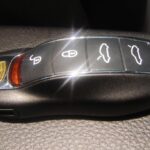Most modern vehicles come equipped with a convenient remote, often referred to as a key fob. These handy devices offer a range of functionalities, from the simple task of locking and unlocking your doors without a physical key to opening the trunk, activating or deactivating the panic alarm, and in some cases, even remotely starting the engine. However, just like any electronic device, key fobs are susceptible to being lost or damaged. When this happens, you’ll likely need to purchase a replacement and program it to work with your car. While it might sound daunting, programming a car remote is often a straightforward process that you can do yourself, provided you follow the correct steps.
Quick Tip: If you find your key fob is acting inconsistently, especially after repeatedly trying to use it when out of range of your car, reprogramming might be the solution. Always attempt to reset your remote before considering replacing it entirely.
Step 1 – Consult Your Car’s Owner’s Manual
Vehicle manufacturers often have slight variations in the programming procedures for their remotes across different models. Therefore, your first and most crucial step should always be to check your car’s owner’s manual. This document is your best resource for model-specific instructions and any prerequisites you should be aware of before attempting to program a new remote. Look for a section on “remote programming,” “key fob synchronization,” or similar terms. The manual might contain specific sequences or security codes relevant to your car.
Step 2 – Vehicle Preparation is Key
Before you begin the programming sequence, ensure your vehicle is properly prepared. This involves making sure that all doors, including the hood and trunk, are completely closed. Once everything is shut, get inside your car, close the driver’s side door, and confirm that all doors are unlocked. Leaving any door, the hood, or the trunk ajar might prevent the programming process from initiating correctly. Typically, your car will alert you to any open entry points with a chime or an indicator light on the dashboard. Resolve these warnings before proceeding.
Step 3 – Initiate the Programming Sequence
Now, insert your car key into the ignition switch, but do not turn it to start the engine yet. Locate the automatic unlock button on your car’s driver-side door panel. Press and hold this unlock button down. While holding the unlock button, turn your key in the ignition to the “accessory” position. This is typically the first position you reach when turning the key clockwise, just before the point where the engine starts. Once you’ve reached the accessory position, release the unlock button. This action should initiate a locking cycle in your car, often indicated by the car locks engaging and then disengaging.
Step 4 – Resetting Your Key Fob
Take your key fob remote and press and hold down both the “lock” and “unlock” buttons simultaneously. Maintain pressure on both buttons for at least 15 seconds. In some vehicle models, the key fob may emit an audible chime or a light might flash on the remote to signal that it has been successfully reset and is ready for programming. This step is crucial for ensuring the fob is in the correct state to learn the car’s security system codes.
Step 5 – Testing the New Programming
To exit the programming mode, turn the ignition switch completely off and remove the key from the ignition. Open the driver’s side door and step out of the vehicle. Now, test every button on your newly programmed key fob. Try locking and unlocking the doors, opening the trunk, and crucially, test the panic alarm button to ensure it is also functioning correctly. If all functions operate as expected, congratulations! You have successfully programmed your car remote. You can repeat this process for any additional new key fobs you need to program for your vehicle.
Step 6 – When to Seek Professional Assistance
If you have meticulously followed these steps and consulted your owner’s manual, but are still unable to program your remote, it might be time to seek professional help. Similarly, if you couldn’t find specific programming instructions in your vehicle’s manual, your local car dealership is a valuable resource. Contact their service department and explain your situation. Dealership technicians are equipped to handle remote programming and can often program the remote for you or guide you through the correct procedure specific to your car model. In many cases, they can also diagnose if there is a more significant underlying issue preventing the remote from being programmed, such as a problem with the car’s security system itself.

